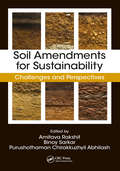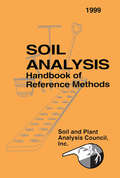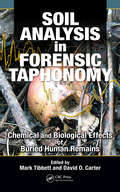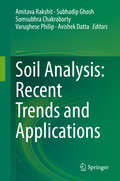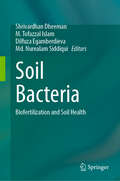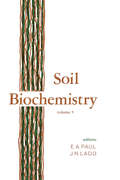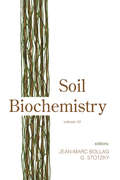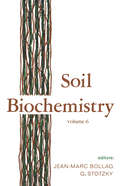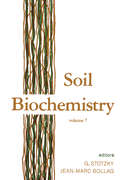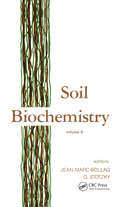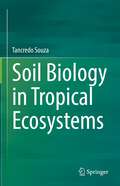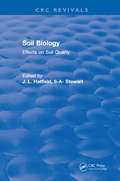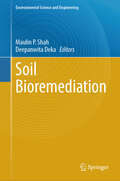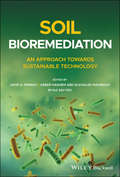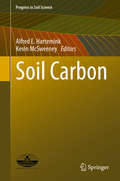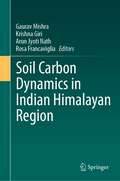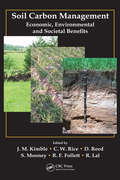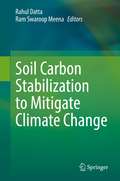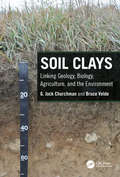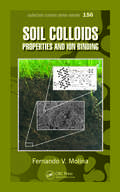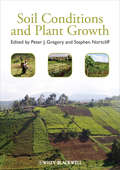- Table View
- List View
Soil Amendments for Sustainability: Challenges and Perspectives
by Amitava Rakshit Binoy Sarkar Purushothaman AbhilashThis book focuses on the pros and cons of amendment materials to restore the functioning of soil resources. It presents a holistic overview on affected land revitalization, clean up and revegetation using these amendments that could be implemented in the long term management of the soil-plant-atmosphereanimal continuum.
Soil Analysis Handbook of Reference Methods
by Soil and Soil and Plant Analysis Council Inc.For more than 30 years, soil testing has been widely used as a basis for determining lime and fertilizer needs. Today, a number of procedures are used for determining everything from soil pH and lime requirement, to the level of extractable nutrient elements. And as the number of cropped fields being tested increases, more and more farmers and growers will come to rely on soil test results. But if soil testing is to be an effective means of evaluating the fertility status of soils, standardization of methodology is essential. No single test is appropriate for all soils.Soil Analysis Handbook of Reference Methods is a standard laboratory technique manual for the most commonly used soil analysis procedures. First published in 1974, this Handbook has changed over the years to reflect evolving needs. New test methods and modifications have been added, as well as new sections on nitrate, heavy metals, and quality assurance plans for agricultural testing laboratories. Compiled by the Soil and Plant Analysis Council, this latest edition of Soil Analysis Handbook of Reference Methods also addresses the major methods for managing plant nutrition currently in use in the United States and other parts of the world. For soil scientists, farmers, growers, or anyone with an interest in the environment, this reference will prove an invaluable guide to standard methods for soil testing well into the future.Features
Soil Analysis in Forensic Taphonomy: Chemical and Biological Effects of Buried Human Remains
by Mark Tibbett David O. CarterA burial environment is a complex and dynamic system. It plays host to an abundance of interdependent chemical, physical, and biological processes, which are greatly influenced by the inclusion of a body and its subsequent decay. However, while taphonomy continues to emerge as a valuable forensic tool, until now most of the attention has been on th
Soil Analysis: Recent Trends and Applications
by Amitava Rakshit Subhadip Ghosh Somsubhra Chakraborty Varughese Philip Avishek DattaSoil analysis is critically important in the management of soil-based production systems. In the absence of efficient methods of soil analysis our understanding of soil is pure guesswork. Ideally the pro-active use of laboratory analysis leads to more sustainable soil productivity. Unfortunately, most of the world’s agriculture is still reactionary, waiting for obvious yield declines to occur before taking action to identify the reasons. The modern soil laboratory is pivotal to informing soil managers what adaptive practices are needed to address chemical and physical imbalances before they occur, and the intelligent adaptive use of laboratory data not only greatly speeds up and reduces the cost of empirical soil study, but can even render it unnecessary. This book provides a synopsis of the analytical procedures used for soil analysis, discussing the common physical, chemical and biological analytical methods used in agriculture and horticulture. Written by experienced experts from institutions and laboratories around the globe, it provides insights for a range of users, including those with limited laboratory facilities, and helps students, teachers, soil scientists and laboratory technicians increase their knowledge and skills and select appropriate methods for soil analysis.
Soil Bacteria: Biofertilization and Soil Health
by Dilfuza Egamberdieva M. Tofazzal Islam Shrivardhan Dheeman Md. Nurealam SiddiquiThis comprehensive exploration delves into the pivotal role of bacteria in soil health, elucidating their mechanisms in organic matter decomposition, metal facilitation, bioremediation of stubborn materials, and nutrient cycling essential for soil fertilization, plant health and conditioning. In an agricultural ecosystem, soil nutrients are the backbone, sourced either externally through fertilizers or internally by the action of soil bacteria. Understanding the intricate concert of soil bacteria within the ecological framework offers three significant advantages: revitalizing soil health and quality (soil reclamation), enhancing soil nutrient availability (biofertilization), and amplifying crop yields in an environmentally sustainable manner (sustainable agriculture). This book caters to a diverse audience including educators, researchers, technocrats, policymakers, agricultural foundations, non-governmental organizations, and particularly research students. It also serves as supplementary material for undergraduate and graduate students across various disciplines such as agriculture, microbiology, biotechnology, forestry, ecology, soil science, and environmental sciences. Additionally, it provides invaluable insights for both national and international agricultural scientists and soil ecologists, enriching their understanding of soil ecosystems and agricultural sustainability.
Soil Basics, Management and Rhizosphere Engineering for Sustainable Agriculture
by Channarayappa C. D P BiradarIncrease in global population, drastic changes in the environment, soil degradation and decrease in quality and quantity of agricultural productivity warranted us to adapt sustainable farming practices. This book focuses on soil health management and creating biased rhizosphere that can effectively augment the needs of sustainable agriculture.
Soil Biochemistry
by E. A. Paul J.N. LaddThis book reviews some aspects of soil biochemistry, including the biochemical turnover of specific elements and organic compounds in soil; the properties and functions of soil enzymes; and the structure, distribution and pathways of metabolism of organic compounds.
Soil Biochemistry, Volume 10 (Books in Soils, Plants, and the Environment)
by Jean-Marc Bollag G. Stotzky Dejan PlavsicAn exploration of the most complex microbial ecosystems with incisive reviews of developments in soil science. It presents techniques of chemical analysis, refinements of environmental protection measures, and methods for maximizing agricultural yields. It also addresses a wide range of biochemical processes and practical applications of advanced b
Soil Biochemistry: Volume 6: Volume 6 (Books In Soils, Plants, And The Environment Ser. #15)
by J.-M. BollagExplores the role of biochemical processes in the soil environment, particularly the activity of microorganisms, and the potential application of those processes to environmental biotechnology. The 11 papers also highlight the application of molecular biology and microbial genetics to soil biology a
Soil Biochemistry: Volume 7
by Jean-Marc Bollag G. StotzkyThis book describes the interactions between soil minerals and microorganisms to more specialized areas such as the formation of desert varnishes. It is helpful for scientists and students who want to extend their knowledge of and research into soil biochemistry.
Soil Biochemistry: Volume 8
by Jean-Marc Bollag G. StotzkyStressing the potential application of biochemical processes in soil to environmental biotechnology, this state-of-the-art reference considers the vital role that such biochemical processes have in the environment - emphasizing the activity of micro-organisms in soil.;An up-to-date analysis of biological reactions in soil, Volume 8 of Soil Biochemistry highlights: traditional as well as molecular and immunlogical techniques for detecting specific micro-organisms in soil; the fate of introduced genetically-modified organisms; the problem of competition by the indigenous microbial populations with the introduced organisms; the use of a white rot fungus, Phanerochaete chrysosporium, for bioremediative purposes in soil; the interaction of xenobiotics, such as pesticides, with soil organisms; generic microbial metabolism and degradation pathways; the inhibition of the nitrification process by allelochemicals released by plants; the microbial mineralization of various compounds under anaerobic conditions, explaining its importance in the global carbon cycle; the formation of soil organic matter, particularly in forest soils; and CPMAS 13C-NMR spectroscopy, a major analytical technique to determine the chemicals or chemical groups involved in the humification process.;Presenting a multidisciplinary approach to the field by internationally acclaimed scientists, Soil Biochemistry, Volume 8 is intended for professionals and students in the fields of soil science; microbiology; biochemistry; environmental science, engineering and technology; biogeochemistry; biotechnology; agronomy; plant pathology; and microbial ecology.
Soil Biology and Agriculture in the Tropics
by Patrice DionThe relationships between soils, microbes and humans are of crucial relevance in the tropics, where plant stress and microbial activity are exacerbated. This volume of Soil Biology presents the living component of tropical soils, showing how it is shaped by environmental conditions and emphasizing its dramatic impact on human survival and well-being. Following an introduction to the specificities of tropical soils and of their microbial communities, the biological aspects of soil management are examined, dealing with land use change, conservation and slash-and-burn agriculture, the restoration of hot deserts, agroforestry and paddy rice cultivation. As they are of particular relevance for tropical agriculture, symbioses of plants and microbes are thoroughly covered, as are the biodegradation of pesticides and health risks associated with wastewater irrigation. Lastly, traditional soil knowledge is discussed as a key to our sustainable presence in this world.
Soil Biology in Tropical Ecosystems
by Tancredo SouzaThis textbook explores the complex nature of soil biological communities and their environments, and covers deserts, rainforests, seasonal tropical forests, dry deciduous forests, and island environments in the tropical zone. It provides essential information on soil biology concepts, ecological processes, plant-soil feedback, trophic structure, and land use effects on soil’s biological properties. The book also offers an updated approach to soil biota and microbiota and their interactions with plants that regulate the structures and functions of tropical ecosystems. Uniquely, it addresses island environments and natural disasters, shedding new light on soil organisms recovering tropical ecosystem functions. Further topics include ecological processes, plant-soil interactions, trophic communities, molecular approaches, and land use, making the book a valuable asset for students, educators and researchers engaged in the Environmental Sciences, Biodiversity and Conservation, Soil Ecology, Soil Biology, Ecology, Zoology, and Soil Biota Classification using classical and molecular tools.
Soil Biology: Effects on Soil Quality (Advances In Soil Science Ser.)
by J. L. HatfieldSoil Biology is a state-of-the art review focusing on the linkage between biological processes that occur in the soil and their impact on soil quality. Topics considered include the microbial ecology of conservation management systems, dynamic processes of vesicular-arbuscular mycorrhizae, earthworms and soil fauna, microbial processes in the soil, and the degradation of pesticides through microbial processes. The book will interest soil scientists, microbiologists, agronomists, and soil ecologists.
Soil Bioremediation (Environmental Science and Engineering)
by Maulin P. Shah Deepanwita DekaThis book is presented on bioremediation of soil including different aspects for sustainable development of agriculture, environment etc. Significant attention is being paid to plants and microbes because of their metabolomics, molecular mechanisms, biochemical pathways, bioengineering, and cost-effective nature in an eco-friendly green approach. It presents a detailed account on phytoremediation, microbial remediation; application of different plants and microorganisms for bioremediation in agricultural soil; nanoparticles, metabolites produced by plants and microbes for bioremediation of soil; multidisciplinary approaches of bioremediation to alleviate major soil contamination issues, molecular mechanisms, biochemical approach of bioremediation of soil; plants and microbial engineering for bioremediation; recent advances and challenges; future prospects of bioremediation of contaminated soil, utilizing biodiversity for sustainable development of the soil ecosystem.
Soil Bioremediation: An Approach Towards Sustainable Technology
by Javid A. Parray Abeer Hashem Abd Elkhalek Mahmoud Riyaz Sayyed.This book will discuss the effective and sustainable technological approaches for remediation of contaminates via eco-friendly usage of microbes. The primary focus will be on the role of microbes, particularly bacteria and fungi, for the degradation and removal of various xenobiotic substances in the environment. The book will also emphasize molecular approaches and biosynthetic pathways of microbes, and present gene and protein expression studies for bio-deterioration techniques. New innovative and sophisticated green technologies for waste minimization and waste control will be presented, as well as the potential of microbes for various techniques of bioremediation, including bio-sorption, bio-augmentation, bio-stimulation, to clean contaminated environments.
Soil Carbon
by Alfred E. Hartemink Kevin McsweeneyFew topics cut across the soil science discipline wider than research on soil carbon. This book contains 48 chapters that focus on novel and exciting aspects of soil carbon research from all over the world. It includes review papers by global leaders in soil carbon research, and the book ends with a list and discussion of global soil carbon research priorities. Chapters are loosely grouped in four sections: § Soil carbon in space and time § Soil carbon properties and processes § Soil use and carbon management § Soil carbon and the environment A wide variety of topics is included: soil carbon modelling, measurement, monitoring, microbial dynamics, soil carbon management and 12 chapters focus on national or regional soil carbon stock assessments. The book provides up-to-date information for researchers interested in soil carbon in relation to climate change and to researchers that are interested in soil carbon for the maintenance of soil quality and fertility. Papers in this book were presented at the IUSS Global Soil C Conference that was held at the University of Wisconsin-Madison, USA.
Soil Carbon Dynamics
by Werner L. Kutsch Michael Bahn Andreas HeinemeyerCarbon stored in soils represents the largest terrestrial carbon pool and factors affecting this will be vital in the understanding of future atmospheric CO2 concentrations. This book provides an integrated view on measuring and modeling soil carbon dynamics. Based on a broad range of in-depth contributions by leading scientists it gives an overview of current research concepts, developments and outlooks and introduces cutting-edge methodologies, ranging from questions of appropriate measurement design to the potential application of stable isotopes and molecular tools. It includes a standardised soil CO2 efflux protocol, aimed at data consistency and inter-site comparability and thus underpins a regional and global understanding of soil carbon dynamics. This book provides an important reference work for students and scientists interested in many aspects of soil ecology and biogeochemical cycles, policy makers, carbon traders and others concerned with the global carbon cycle.
Soil Carbon Dynamics in Indian Himalayan Region
by Rosa Francaviglia Arun Jyoti Nath Gaurav Mishra Krishna GiriThe contributed volume assimilates the knowledge, experience, and exciting aspects of soil carbon research in the Indian Himalayan region. It includes different aspects and factors associated with soil carbon sequestration in the region, one of the biodiversity hot spots and highly vulnerable to climatic change impacts. Information on different aspects of soil organic carbon dynamics concerning adaptive land management practices and anthropogenic impacts is covered. Further topics include applying advanced tools and techniques to soil carbon vis-a-vis soil erosion research. This book is of interest to researchers and policymakers involved in soil carbon research and offer ideas to enhance the soil carbon in the region concerned. In addition, the book will provide up-to-date information for researchers interested in soil carbon research for the maintenance of soil quality and fertility in the climate-vulnerable Indian Himalayan region.
Soil Carbon Management: Economic, Environmental and Societal Benefits
by R. Lal J. M. Kimble C. W. Rice D. Reed S. Mooney R. F. FollettBetter Manage Soil C for Improved Soil Quality In the United States, soil has fueled the availability of abundant, safe food, thus underpinning economic growth and development. In the future we need to be more vigilant in managing and renewing this precious resource by replacing the nutrients and life-sustaining matter that we remove for
Soil Carbon Stabilization to Mitigate Climate Change
by Ram Swaroop Meena Rahul DattaCarbon stabilization involves to capturing carbon from the atmosphere and fix it in the forms soil organic carbon stock for a long period of time, it will be present to escape as a greenhouse gas in the form of carbon dioxide. Soil carbon storage is an important ecosystem service, resulting from interactions of several ecological processes. This process is primarily mediated by plants through photosynthesis, with carbon stored in the form of soil organic carbon. Soil carbon levels have reduced over decades of conversion of pristine ecosystems into agriculture landscape, which now offers the opportunity to store carbon from air into the soil. Carbon stabilization into the agricultural soils is a novel approach of research and offers promising reduction in the atmospheric carbon dioxide levels. This book brings together all aspects of soil carbon sequestration and stabilization, with a special focus on diversity of microorganisms and management practices of soil in agricultural systems. It discusses the role of ecosystem functioning, recent and future prospects, soil microbial ecological studies, rhizosphere microflora, and organic matter in soil carbon stabilization. It also explores carbon transformation in soil, biological management and its genetics, microbial transformation of soil carbon, plant growth promoting rhizobacteria (PGPRs), and their role in sustainable agriculture. The book offers a spectrum of ideas of new technological inventions and fundamentals of soil sustainability. It will be suitable for teachers, researchers, and policymakers, undergraduate and graduate students of soil science, soil microbiology, agronomy, ecology, and environmental sciences
Soil Classification: A Global Desk Reference
by Hari Eswaran B. A. Stewart Robert Ahrens Thomas J. RiceDevelopments in soil classification have accompanied parallel progress in our understanding of the soil system. However the theories behind the classifications and the purposes for which they were created have changed over time. The editors hope that this comprehensive synthesis will help to rally soil scientists around the world to develop an acce
Soil Clays: Linking Geology, Biology, Agriculture, and the Environment
by G. Jock Churchman Bruce VeldeAs the human population grows from seven billion toward an inevitable nine or 10 billion, the demands on the limited supply of soils will grow and intensify. Soils are essential for the sustenance of almost all plants and animals, including humans, but soils are virtually infinitely variable. Clays are the most reactive and interactive inorganic compounds in soils. Clays in soils often differ from pure clay minerals of geological origin. They provide a template for most of the reactive organic matter in soils. They directly affect plant nutrients, soil temperature and pH, aggregate sizes and strength, porosity and water-holding capacities. This book aims to help improve predictions of important properties of soils through a modern understanding of their highly reactive clay minerals as they are formed and occur in soils worldwide. It examines how clays occur in soils and the role of soil clays in disparate applications including plant nutrition, soil structure, and water-holding capacity, soil quality, soil shrinkage and swelling, carbon sequestration, pollution control and remediation, medicine, forensic investigation, and deciphering human and environmental histories. Features: Provides information on the conditions that lead to the formation of clay minerals in soils Distinguishes soil clays and types of clay minerals Describes clay mineral structures and their origins Describes occurrences and associations of clays in soil Details roles of clays in applications of soils Heavily illustrated with photos, diagrams, and electron micrographs Includes user-friendly description of a new method of identification To know soil clays is to enable their use toward achieving improvements in the management of soils for enhancing their performance in one or more of their three main functions of enabling plant growth, regulating water flow to plants, and buffering environmental changes. This book provides an easily-read and extensively-illustrated description of the nature, formation, identification, occurrence and associations, measurement, reactivities, and applications of clays in soils.
Soil Colloids: Properties and Ion Binding (Surfactant Science)
by Fernando V. MolinaWithin the field of soil science, soil chemistry encompasses the different chemical processes that take place, including mineral weathering, humification of organic plant residues, and ionic reactions involving natural and foreign metal ions that play significant roles in soil. Chemical reactions occur both in the soil solution and at the soil part
Soil Conditions and Plant Growth
by Peter J. Gregory Stephen NortcliffBuilding on the extremely successful and popular Russell’s Soil Conditions and Plant Growth, Wiley-Blackwell is pleased to publish this completely revised and updated edition of the soil science classic. Covering all aspects of the interactions between plant and soil, Peter Gregory and Stephen Nortcliff, along with their team of internationally-known and respected authors, provide essential reading for all students and professionals studying and working in agriculture and soil science. Subject areas covered range from crop science and genetics; soil fertility and organic matter; nitrogen and phosphoros cycles and their management; properties and management of plant nutrients; water and the soil physical environment and its management; plants and change processes in soils; management of the soil/plant system; and new challenges including food, energy and water security in a changing environment. Providing a very timely account on how better to understand and manage the many interactions that occur between soils and plants, Soil Conditions and Plant Growth is sure to become the book of choice - as a recommended text for students and as an invaluable reference for those working or entering into the industry. An essential purchase for all universities and research establishments where agricultural, soil, and environmental sciences are studied and taught.
